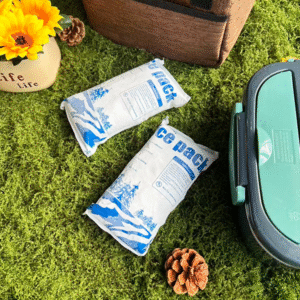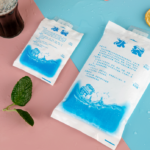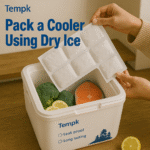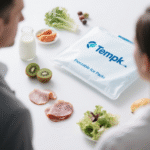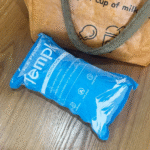Shipping perishable goods safely can make or break your online business. Um online dry ice pack is a specialised coolant that lets you order temperature control solutions through digital channels and have them delivered straight to your door. Whether you’re shipping frozen seafood across the country or vaccines across town, understanding how these packs work will help you avoid spoilage and meet stringent regulations. Gelo seco, feito de dióxido de carbono sólido, is exceptionally cold (−109.3 °F or −78.5 °C) and turns directly from a solid to gas, leaving no wet residue. Newer “dry ice packs” use a super absorbent polymer (SEIVA) that soaks up water and freezes into a flexible gel, offering an eco friendly alternative. This guide explains how to choose the right pack, handle it safely, compare it with other cold packs and explore 2025 tendências.
Understand what “online dry ice pack” means and how it differs from gel or water packs, including SAP based dry ice packs.
Choose the right pack based on shipment weight, duration and product sensitivity.
Follow best practices for safe handling, packaging and labelling with international regulations.
Compare dry ice with gel and water packs using a clear pros/cons table.
Discover the latest 2025 tendências, such as eco friendly materials and IoT enabled smart packs, and see how the market is growing.
What makes an online dry ice pack essential in e commerce?
Dry ice packs keep products frozen during long distance shipping. O gelo seco mantém temperaturas extremamente baixas (−109.3 °F/−78.5 °C) and sublimates into gas, so it doesn’t leave melted water that could damage packaging. Because of this, dry ice is ideal for shipping high value frozen foods, pharmaceuticals and biologics. E commerce businesses can order these packs online, tailor the size and quantity to their shipment and have them delivered on demand. Modern dry ice packs often combine CO₂ based cores with insulating shells and protective casings to withstand rough handling.
Why e commerce needs digital ordering of cold packs
Ordering cold chain supplies online streamlines logistics for small and medium sized businesses. Instead of sourcing dry ice locally, companies can purchase pre measured packs via web platforms. This digital model ensures consistency: packaging providers often validate their packs with temperature studies and provide performance data, making compliance easier. Online ordering also enables subscription models and just in time delivery, reducing storage needs and inventory costs for merchants.
Differences between CO₂ dry ice packs and SAP based “dry ice packs”
There are two main categories of packs sold as “dry ice.”
| Pack type | Cooling mechanism | Vantagens | Limitations |
| CO₂ dry ice pack | Solid carbon dioxide sublimates into gas and absorbs heat | Ultra low temperatures, long duration, no residue | Requires special handling and labels; limited life (5–10 lb loss per 24 h) |
| SAP based dry ice pack (hydrate type) | Super absorbent polymer absorbs water, freezes into a gel | Flexible after freezing, lightweight and space saving; non toxic, ecologicamente correto | Provides refrigerated (not ultra cold) temperaturas; must be soaked and frozen before use |
| Pacote de gel | Non toxic refrigerant gel freezes and releases cold gradually | Reutilizável, seguro de manusear, cost effective for chilled shipments | Not cold enough for frozen goods; risk of leakage if punctured |
| Water/ice pack | Frozen water provides chilled temperatures (2–8 ° C.) | Very low cost and easy disposal | Less thermal retention; rigid when frozen |
SAP packs are often called “dry ice packs” even though they contain no CO₂; they are popular for meal kits, pharmaceuticals and grocery deliveries because they provide a stable chilled environment and are reusable. Understanding these differences helps you pick the correct solution for your products.
Exemplo do mundo real
Imagine an online seafood vendor in Los Angeles shipping frozen salmon to customers nationwide. They use a smartphone app to order 10 pound CO₂ dry ice packs that arrive the next day. The vendor places the packs inside a polystyrene foam container and then in a corrugated box. Because dry ice sublimates at about five to ten pounds per 24 horas, the vendor adds extra packs to cover potential shipping delays. Clear “Dry Ice – UN 1845” labels and hazard class 9 stickers comply with DOT and IATA regulations. This approach keeps the salmon frozen for over 48 horas, ensuring customers receive a high quality product.
Dicas e sugestões práticas
For frozen foods: Use CO₂ dry ice packs for items like ice cream and meat; combine with gel packs for multi day journeys.
Para produtos farmacêuticos: Choose high density foam containers and validated packs to maintain strict temperature ranges.
For chilled goods: SAP based packs or gel packs provide refrigerated temperatures (2–8 ° C.) without over freezing.
Always order extra: Adicionar 10 lb of dry ice for every extra day of transit to cover delays.
Exemplo de caso: A biotechnology firm shipping blood samples used a combination of CO₂ dry ice and gel packs. By following UPS guidelines for calculation (five to ten pounds of dry ice per 24 horas) and adding extra for delays, they maintained specimens at -70 ° C para 72 horas, meeting regulatory requirements and avoiding expensive reshipments.
How to choose the right online dry ice pack for your shipment
Selecting the appropriate pack requires balancing product requirements, transit duration and regulatory compliance. Here’s how to decide.
Key factors
- Product type and temperature range.Identify whether your item needs to be congelado, refrigerado, or simply kept legal. Para produtos congelados (por exemplo, frutos do mar, sorvete, amostras biológicas), CO₂ dry ice is best. Para produtos gelados (pharmaceuticals at 2–8 °C), gel or SAP packs are sufficient.
- Shipment weight and duration.Dry ice sublimates at 5–10 lb per day. Mercury’s shipping guide recommends 5–10 lb of dry ice per day for items weighing up to 12.5 lb and at least 20 lb for a two day journey. Always factor in the weight of your payload when ordering online.
- Packaging and insulation.Use expanded polystyrene foam containers placed inside sturdy corrugated boxes to reduce sublimation and protect the contents. FedEx cautions against airtight containers; pressure build up can rupture packaging and glass may crack. Dry ice should never touch the product directly; use partitions or trays to prevent over freezing.
- Regulatory compliance.O gelo seco é classificado como um material perigoso. Packages must be vented, labelled with “Dry Ice” or “Carbon Dioxide Solid,” and display the net quantity and UN 1845 number. Aula 9 hazard labels must measure at least 100 mm × 100 milímetros. Many carriers restrict the amount of dry ice per package (por exemplo, 200 kg maximum at FedEx), and international shipments require compliance with IATA Packing Instruction 954.
- Sustainability and reuse.Consider whether you can return and reuse packs. Reusable cold packs and SAP packs lower long term costs and reduce waste. CO₂ dry ice is single use; leftover dry ice must be allowed to sublimate in a ventilated area.
Extended explanation
When choosing a pack, match the cooling agent to your product’s sensitivity. A B2B meal kit service shipping fresh produce can use gel or SAP packs because these maintain 2–8 °C without freezing the vegetables. No entanto, an online butcher shipping frozen steaks should opt for CO₂ dry ice to keep meat solid. Duration matters: UPS suggests calculating dry ice based on the expected transit time plus a buffer for delays. Mercury adds that you should add at least 10 lb of dry ice for an extra day. Packaging also influences efficiency; high density foam from validated suppliers slows sublimation, while polyurethane or vacuum insulated panels may allow longer durations.
Choosing guidelines table
| Cenário | Recommended pack | Approximate quantity | Practical notes |
| Alimentos congelados (<12.5 Libra) shipped overnight | CO₂ dry ice pack | 5 lb per day | Use EPS foam container and vented corrugated box |
| Frozen goods for a two day journey | Co₂ gelo seco + pacotes de gel | ≥20 lb dry ice | Adicionar 10 lb extra to cover delays |
| Chilled pharmaceuticals (2–8 ° C.) | Gel or SAP pack | Weight equal to 50–100 % of the product | Combine with validated insulation; monitor temperature digitally |
| Meal kits or grocery deliveries | SAP based “dry ice” pack | Mergulhe por 15 min then freeze | Flexible and reusable; safe for consumers |
| Long distance (internacional) Remessas | CO₂ dry ice pack + smart sensor | 30 % more dry ice than domestic shipments | Ensure IATA compliance and real time tracking |
Tips for different scenarios
Remessas curtas (<24 h): Use equal weight dry ice to the payload for frozen goods or gel packs for chilled items.
Multi day journeys: Combine dry ice with gel packs; add at least 25 % more dry ice for each extra day.
Customers unfamiliar with dry ice: Opt for SAP or gel packs to avoid handling hazards.
Sustainability goals: Incorporate reusable packs or SAP packs that are non toxic and recyclable.
How to safely handle and ship online dry ice packs
Because dry ice is extremely cold and classified as hazardous, proper handling is critical to protect workers and comply with regulations.
Safety fundamentals
Wear protective gear. UPS recommends goggles, special insulated gloves and bibs for anyone handling dry ice. Dry ice can cause frostbite and severe burns on skin. Always work in a well ventilated area because sublimating CO₂ can displace oxygen and cause suffocation.
Use proper containers. FedEx 2025 Dry Ice Job Aid warns that packaging must release gas to prevent pressure build up. Do not use steel drums or sealed plastic bags and avoid glass containers, which may crack under cold stress. Use good quality fiberboard or plastic boxes lined with polystyrene foam. Foam should not be airtight; cut vent holes or leave plugs open for gas to escape. The maximum allowed dry ice per package is 200 kg.
Separate products from the dry ice. UPS instructs shippers to keep contents separate from the dry ice; its job is to cool, not to contact the product directly. Use partitions or wrap products in waterproof plastic before placing them in insulated containers. Do not make the entire outer box airtight because dry ice needs ventilation.
Etiqueta claramente. Mark the package with “Dry Ice” or “Carbon Dioxide Solid” and the UN 1845 number. State the net quantity of dry ice in kilograms and include shipper and recipient addresses. FedEx requires Class 9 hazard diamonds of at least 100 mm on each side. UPS also requires compliance with 49 Cfr 173.217 for domestic shipments and IATA packing instruction 954 for international shipments.
Train staff and maintain documentation. Only trained employees should pack and ship dry ice. Keep records of thermal performance, lane specific validation and monitoring devices as part of Good Distribution Practice (PIB) conformidade.
Explicação expandida
Safety extends beyond protective gear. Choose packaging materials that facilitate gas escape; por exemplo, FedEx approves fiberboard boxes with polystyrene liners and prohibits polystyrene foam as outer packaging unless preapproved. When labelling, the proper shipping name and hazard label must be on the same surface of the package. For large packages (capacidade >30 kg), E 1845 text must be at least 12 mm de alto. UPS recommends adding enough dry ice to cover an extra day in transit to mitigate delays. eShipper emphasises using sturdy foam insulated containers and avoiding airtight seals to allow CO₂ to vent.
Table of packaging and labelling requirements
| Exigência | Carrier recommendation | Meaning for your shipment |
| Ventilação | Packaging must allow gas release; do not seal plugs or use airtight containers | Prevents pressure build up and explosion |
| Caixa externa | Use fiberboard, plastic or wood boxes; no steel drums | Provides structural strength and reduces damage |
| Isolamento | Polystyrene foam layer, not sealed to be airtight | Minimises heat transfer and prolongs cooling |
| Maximum weight | 200 kg de gelo seco por pacote | Stay within regulatory limits |
| Rótulos | Mark with “Dry Ice,” UN 1845, net quantity, shipper/receiver addresses; use Class 9 diamond ≥100 mm | Ensures compliance with DOT and IATA regulations |
| Documentação | Keep training records and thermal validation data | Facilitates audit and regulatory compliance |
Conselhos práticos
Ventive seu contêiner: Loosen tape near one corner or use a foam insert with holes to allow CO₂ gas to escape.
Never store dry ice in sealed walk in freezers or refrigerators: Build up of CO₂ can displace oxygen.
Use temperature monitors: Place data loggers or smart sensors inside the package to verify that the temperature remains within range.
Dispose responsibly: Após a entrega, allow leftover dry ice to sublimate in a well ventilated area away from people and pets.
Comparing online dry ice packs with gel and water packs
Different cooling agents excel in different scenarios. Understanding their strengths and weaknesses helps you select the right tool for each shipment.
Pros and cons
Gelo seco (Co₂). The biggest advantage of dry ice is its exceptionally low temperature; it can keep items frozen at −109.3 °F for long periods. It is lighter than cold packs, which can reduce shipping costs, and it leaves no liquid residue because it sublimates. No entanto, it requires special handling and gloves, carries regulatory restrictions and is single use.
Pacotes de gel. Gel packs are flexible pouches filled with a non toxic refrigerant. They freeze at temperatures slightly below 0 °C and provide consistent cooling for chilled (2–8 ° C.) bens. Gel packs are reusable and safe to handle. Drawbacks include the risk of leakage if punctured and limited cooling capacity; they cannot maintain extremely low temperatures.
Water/ice packs. Ice packs are low cost pouches filled with water, ideal for short to mid duration chilled shipments. They are easy to dispose of and involve no chemical additives. Their thermal mass is lower than gel or dry ice, so they warm up faster.
SAP based “dry ice packs.” These packs consist of SAP beads sealed in non woven fabric; when soaked and frozen, they form a gel that stays flexible. They are lightweight and space saving, non toxic and environmentally friendly. They provide refrigerated temperatures rather than ultra cold conditions and must be prepared (soaked and frozen) antes de usar.
Comparison table
| Cooling agent | Faixa de temperatura | Duração | Handling complexity | Best suited for |
| Gelo seco (Co₂) | Congelado (≤−78 °C) | 24–48 h with sufficient quantity | High – protective gear and regulatory labels | Frozen meats, frutos do mar, vacinas, Biologics |
| Pacote de gel | 2–8 ° C. | 24–48 h | Low – reusable and non toxic | Kits de refeições, produzir, laticínio, produtos farmacêuticos |
| Water/ice pack | 2–8 ° C. | <24 h | Very low – simple disposal | Short distance grocery deliveries and subscription boxes |
| SAP based pack | 0–8 ° C. | 24–36 h | Low – soak and freeze; non toxic | E commerce meal kits, produtos farmacêuticos, e grocery |
Tips to decide
Para congelado goods requiring ultra low temperatures, choose CO₂ dry ice packs; add gel packs only if you need to extend duration.
Para refrigerado bens (2–8 ° C.), use gel or SAP packs because they provide stable temperatures without freezing your product.
When packaging multiple items with different temperature needs, partition the container and use a combination of packs.
Consider the environmental impact and regulatory complexity; SAP and gel packs are easier for consumers to dispose of and reuse.
2025 developments and trends in online dry ice packs
Visão geral da tendência
The cold chain industry is evolving rapidly as e commerce and sustainability goals reshape requirements. Key developments in 2025 incluir:
Materiais ecológicos. Manufacturers are moving towards sustainable and recyclable materials for dry ice packs. Biodegradable insulation and plant based polymers help reduce carbon footprints.
Smart technology integration. Some packs now contain temperature sensors and data loggers that provide real time tracking via IoT. Smart packs allow shippers to monitor conditions and prove compliance during transit.
Growth of e commerce. The rise in online grocery and pharmaceutical sales drives demand for reliable cold chain solutions. Durable dry ice pack suppliers note a surge in orders from meal kit companies and online pharmacies.
Reusable packaging markets. The reusable cold chain packaging industry is forecast to grow from USD 4.97 bilhão em 2025 para USD 9.13 bilhão por 2034, with a compound annual growth rate (Cagr) de 6.98 %. Growth is driven by sustainability mandates, rising biologics shipments and e commerce demand.
Regulatory digitisation. Cold chain providers increasingly offer digital documentation and blockchain for traceability, making it easier to comply with GDP and FDA requirements.
Latest advancements at a glance
Eco materials: New recyclable insulation fabrics and paper based box liners reduce waste while maintaining thermal performance.
IoT and sensors: Smart packs embed sensors that send alerts if temperatures deviate from required ranges. This helps prevent spoilage and provides data for audits.
Customised solutions: SAP based packs now offer customised shapes and sizes; some include printed graphics for branding. Users can order exact quantities via online platforms.
AI assisted logistics: Machine learning models predict dry ice consumption based on weather, route and carrier performance, optimising pack selection.
Insights de mercado
Analysts estimate that the global reusable cold chain packaging market will expand from approximately USD 4.97 bilhão em 2025 to more than USD 9.13 bilhão por 2034. Growth is driven by sustainability requirements, increasing shipments of pharmaceuticals and biologics, and the rapid expansion of online meal kit and grocery services. North America currently leads adoption, while Asia–Pacific markets are catching up quickly. Reusable insulated boxes and pallet shippers dominate product segments, and IoT enabled tracking containers are expected to grow at the fastest rate.
The chart above visualises the anticipated growth of the reusable cold chain packaging market, illustrating the industry’s expansion and the increasing importance of sustainable logistics.
Perguntas frequentes
Q1: Can I reuse dry ice packs ordered online?
Reusable SAP based packs and gel packs can be refrozen and reused multiple times. Traditional CO₂ dry ice packs cannot be reused because they sublimate completely. Always follow the manufacturer’s guidelines for reusability.
Q2: How long do online dry ice packs last?
The cooling duration depends on the pack type and quantity. CO₂ dry ice typically lasts 12–48 hours, with five to ten pounds sublimating per day. SAP based packs and gel packs provide chilled temperatures for 24–48 hours. Always add extra packs to account for unexpected delays.
Q3: Are SAP based dry ice packs safe for food contact?
Sim. SAP packs are made from non toxic super absorbent polymer and water. Leakage does not cause environmental pollution and disposal is straightforward.
Q4: What regulations apply to shipping dry ice?
Shipping dry ice by air must comply with IATA packing instruction 954 and UN 1845 labelling requirements. Domestic shipments in the United States must meet 49 Cfr 173.217. You must label packages with “Dry Ice” or “Carbon Dioxide Solid” and include the net quantity and shipper/receiver addresses.
Q5: Can I mix dry ice and gel packs in one shipment?
Sim. Combining CO₂ dry ice with gel packs can extend cooling duration, especially for multi day shipments. Pack the dry ice at the top of the container and gel packs around the sides. Ensure the container is ventilated to allow CO₂ to escape.
Resumo e recomendações
Escolhendo o direito online dry ice pack can make the difference between a spoiled shipment and a satisfied customer. Dry ice maintains ultra cold temperatures and is best for frozen goods, while gel and SAP packs provide safe, flexible options for chilled shipments. Proper handling is essential: always wear protective gear, use vented containers, and label packages according to regulations. Em 2025, trends like eco friendly materials, IoT enabled monitoring and growing e commerce demand are reshaping the market. The reusable cold chain packaging industry is projected to almost double by 2034, highlighting the shift towards sustainable logistics.
ACTO ACEDIVO PRÓXIMO PASSOS
Avalie as necessidades de temperatura do seu produto. Decide whether your items require freezing or just chilling.
Use our online calculator (coming soon) to determine how many pounds of dry ice or how many gel packs you need based on weight, transit time and ambient conditions.
Select the right pack: Para produtos congelados, order CO₂ dry ice packs online. For chilled goods, choose gel or SAP packs.
Follow safety protocols: Purchase protective gloves, ensure packaging has venting and label your shipment correctly.
Considere a sustentabilidade: Explore reusable packaging options to reduce waste and costs.
Sobre Tempk
Tempk specialises in durable dry ice packs and other cold chain solutions. Our products combine high performance insulation, robust outer shells and CO₂ based cores to deliver low temperatures over extended periods. We also offer SAP based hydrate packs, gel packs and insulated bags for chilled shipments. Our focus on innovation and sustainability drives our research into eco friendly materials and smart technology integration. We are committed to helping businesses maintain product quality while meeting regulatory and environmental requirements. Get in touch to discuss tailored solutions for your cold chain needs.






